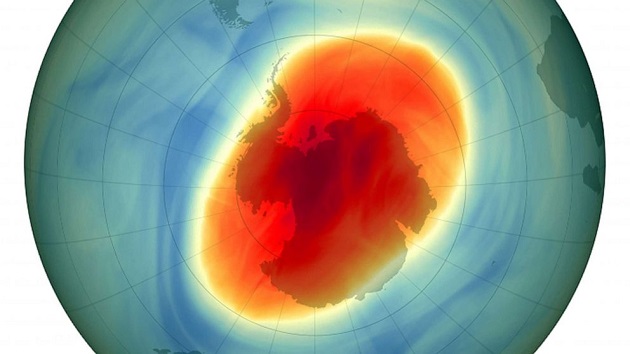(NEW YORK) — When the hole in the ozone layer was first discovered in 1985, Paul A. Newman was shaken as a scientist.
“I lost a lot of sleep back then because we didn’t really know what was going on and then we didn’t know how it would really play out,” he told ABC News.
Scientists were soon able to discover the cause: chlorofluorocarbons, or CFCs — chemicals commonly used in the production of aerosol sprays, refrigerators and air conditioners. Once broken down in the upper atmosphere by high ultraviolet radiation, they release ozone-depleting chlorine.
The Montreal Protocol, a universally ratified United Nations treaty that went into effect in 1989, phased out the production of ozone-depleting substances including CFCs. And the U.N.’s most recent four-year assessment of those efforts, published Monday, found that the ozone layer — which protects the planet against harmful radiation that’s linked to skin cancer and crop damage — is slowly continuing to recover.
“I’ve slept pretty well the last few years,” Newman, a co-chair of the scientific assessment, said. “There’s still problems with climate, but as far as the ozone layer, I think we’re moving to be in good shape.”
Ozone recovery
The latest report looking at the progress of the Montreal Protocol found that emissions of human-produced ozone-depleting substances like CFCs, which were once widely used, have “come down substantially,” Newman said.
The report confirmed the phase-out of nearly 99% of banned ozone-depleting substances, the U.N. said. A few years ago, there were unexpected emissions of one of the banned chemicals — chlorofluorocarbon-11, or CFC-11 — in eastern China, though those numbers have also gone back down to expected levels, Newman said.
The levels of ozone-depleting substances in the atmosphere are also continuing to decline, despite the “hiccup” in CFC-11 emissions, Newman said. Chlorine levels are down 11.5% from a peak in 1993, while levels of bromine, another ozone-depleting atom, are down 14.5% from a 1999 peak, according to the report.
As a result, ozone is increasing in the upper stratosphere, Newman said. If current policies remain in place, the ozone layer is expected to recover to 1980 levels by 2040, while over the Antarctic, this recovery is expected by around 2066, the report said.
“That’s really good news. It really shows that the Montreal Protocol is working,” Newman said. “We knew that if you curtailed or if you stopped the growth of chlorofluorocarbons, and they came down, that ozone would recover. And not only do we see that recovery, but it’s recovery at the expected rate.”
Areas of concern
There are areas of concern that could thwart this expected progress, Newman noted, such as unexplained increases in banned ozone-depleting substances like CFC-11.
It is also unclear what impact technology like high-altitude aircraft or geoengineering — a method of artificially cooling the planet by introducing aerosols into the stratosphere to increase sunlight reflection — could have, he said.
For the first time, the assessment looked at the potential impact of geoengineering on ozone and found that an “unintended consequence” was that it “could also affect stratospheric temperatures, circulation and ozone production and destruction rates and transport,” the report said.
“Volcanoes, when they spew particles into the stratosphere, it has a direct impact on the ozone layer. So if man starts doing the same thing to cool the Earth’s surface, it’s going to have an impact on the ozone layer,” Newman said. “I think we’re in good shape, but we need to be vigilant to make sure that we don’t do something like this again.”
Copyright © 2023, ABC Audio. All rights reserved.












